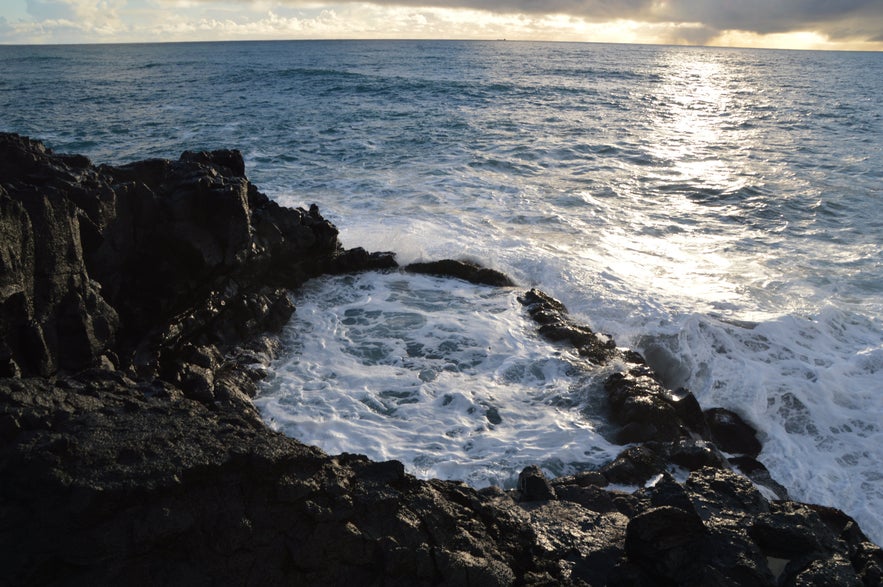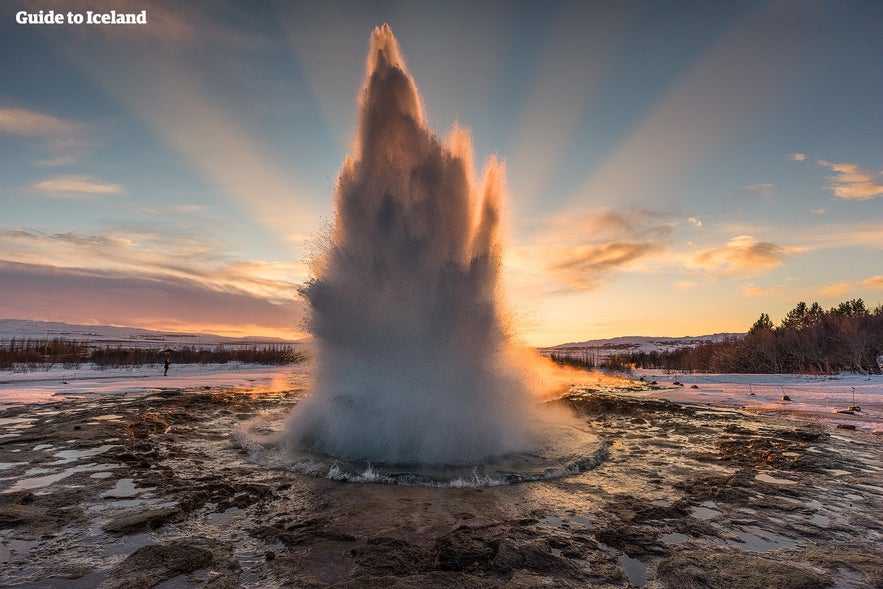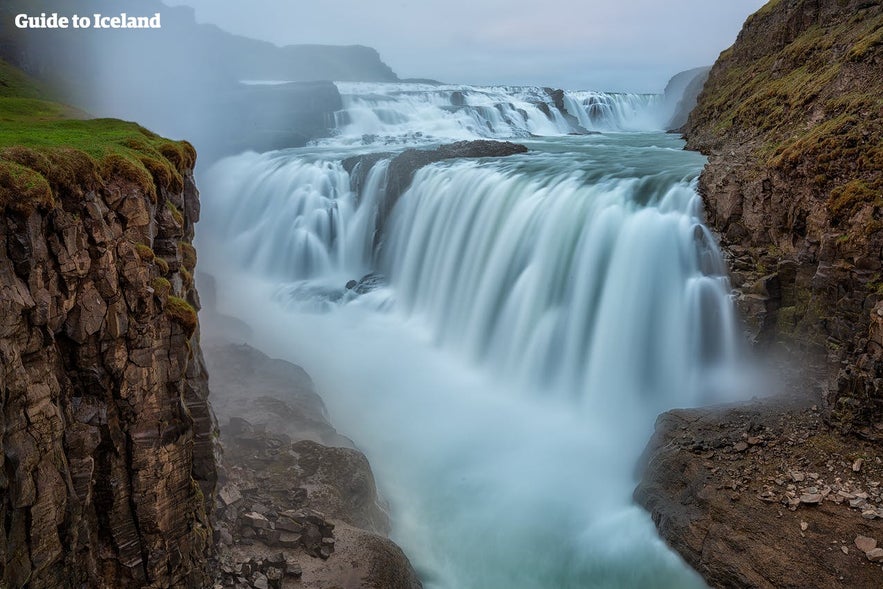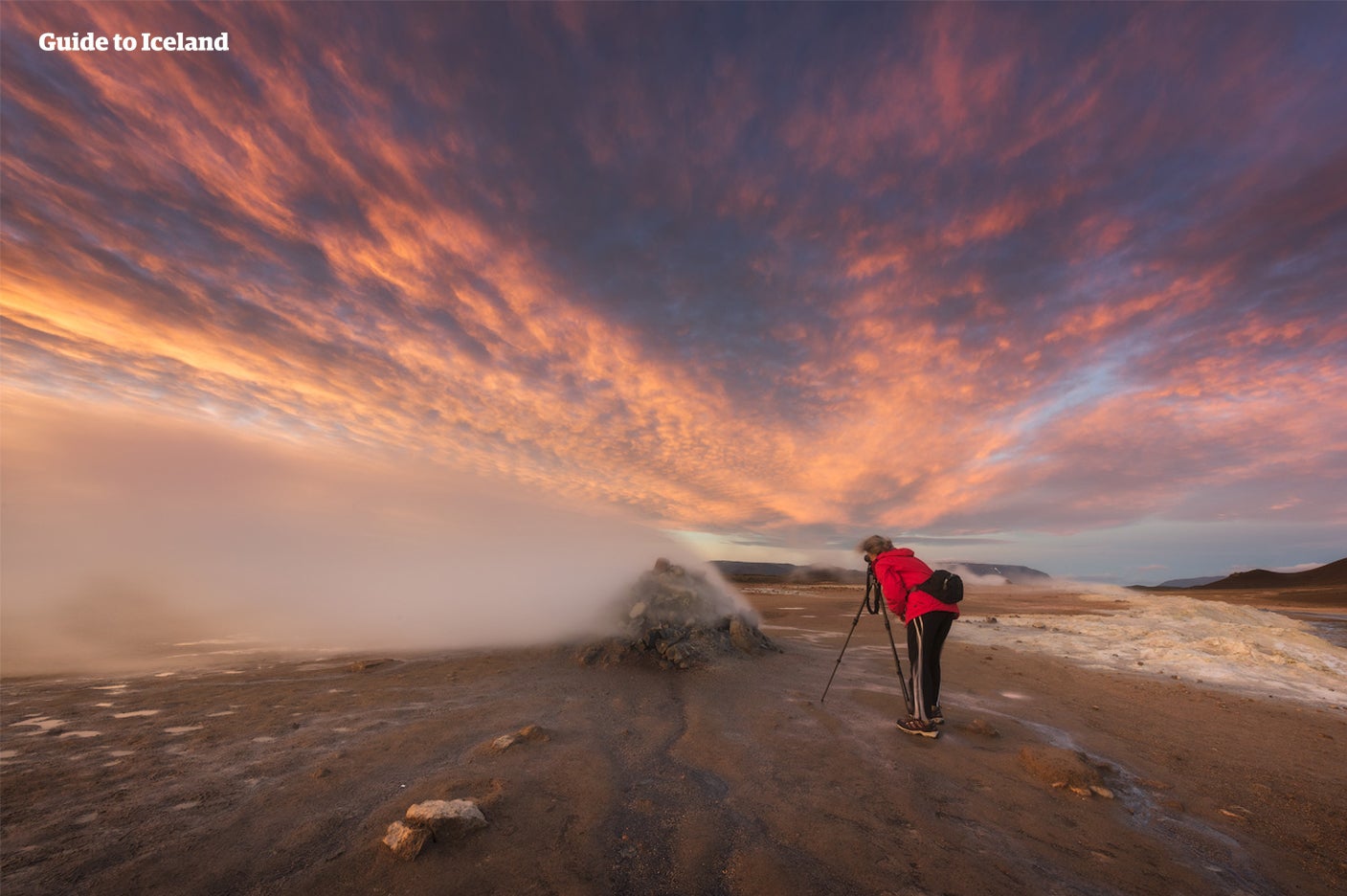How can you spend a week in Iceland without breaking the bank? Is it possible to travel cheaply in Iceland while still partaking in the activities on offer? Find out how to spend seven affordable adventure-filled days in Iceland.
- Save money on a long holiday with this 12 Day Budget Self Drive Tour | The Ring Road and National Parks
- Find out more by reading How Expensive is Iceland?
- Enjoy an affordable long weekend with this 4 Day Budget Self Drive Tour | The Golden Circle and Glaciers
- Discover 19 Tips on how to Save Money in Iceland
The following guide is based on the presumption that you want to see as much of Iceland as possible, with time at both the famous locations and hidden gems. It also works off the guess that you would like to fit in a few great value tours to truly make the most of your time on the island.
Why You Can Trust Our Content
Guide to Iceland is the most trusted travel platform in Iceland, helping millions of visitors each year. All our content is written and reviewed by local experts who are deeply familiar with Iceland. You can count on us for accurate, up-to-date, and trustworthy travel advice.
This itinerary is tailored to those visiting Iceland in summer, where the never-setting midnight sun allows you to spend as long as you like sightseeing. Of course, depending on whether you are on a very tight budget or just looking to shave costs, you can adjust your own plans accordingly.
Day One: Arrival in the Capital

Your week starts with a morning arrival at Keflavík International Airport. Instead of rushing through customs, you should take your time and pick up whatever alcohol you think you'll need for the trip, as it is only otherwise sold in government shops for double the price.
Once you have what you need, you will pick up the budget rental car you booked, and begin your drive. The haunting, lunar lava fields and daunting volcanoes of the Reykjanes Peninsula will awe you as you pass them by, but do not worry about missing out; you’ll have plenty of time to explore this area later.
For now, however, your intention is to shop for groceries, so you head to a budget supermarket in Rekjavík, such as Bónus, Hagkaup, or Krónan, to get yourself food for the week. Afterwards, you will go to your equipment rental to pick up your tents and sleeping bags if you did not bring your own; after all, camping is the very best way to immerse yourself in Iceland's nature.
- Find out more with Camping in Iceland | All You Need to Know

Your destination is the Reykjavík Campsite in Laugardalur. The swimming pool you will start your holiday basking in is right beside your campsite, called Laugardalslaug. You can spend as long as you want to recharge yourself here, in Iceland’s largest geothermally heated outdoor pool, sweating it out in the sauna and steam room and relaxing in the hot pools.
The entrance fee into this enormous spa is 950 ISK. Once you are ready, you’ll start your afternoon exploring the sites of the capital.
As it is located in Laugardalur Park, the same place as your campsite, you can start by visiting the Ásmundur Sveinsson Sculpture Museum to admire the incredible early 20th Century pieces. The 1,600 ISK admission ticket is valid for 24 hours and provides access to three other museums as well.
Next, therefore, you head to the Kjarvalsstaðir Art Museum for an entirely different showcase of Icelandic talent, this time focusing on the works of Jóhannes S. Kjarval, arguably the country's most important painter.
- Find out more with The Best Swimming Pools in Iceland
- Find out more with 9 Best Cheap Things to Do in Reykjavík
As evening comes around, you will head to the top of Hallgrímskirkja church for some magnificent views across the capital.
You will want to make more of your city pass, but there will be time in the morning. For now, it’s time to find a cheap meal, grab a happy hour beer or glass of wine before you head to your tent for the night.
- Find out more with Sightseeing in Reykjavík
Day Two: Hot Spring Valley and the Golden Circle
On day two, you will rise early, have a hearty breakfast at the campsite, before starting your morning at the National Museum of Iceland. After spending a couple of hours admiring the diverse exhibitions here, you hop back into your car and start exploring the greater outdoors.
Your first destination will be Hveragerði, or ‘the earthquake town’, about forty-five minutes south-east of Reykjavík. Here, you will see the mountains steaming with fumaroles, and a hiking path winding through them.
You will take this beautiful 1.5-hour trek, over and around the peaks, until you come to Reykjadalur, the heart of the area’s geothermal activity. A river steams before you, fed by both cool water and the boiling springs, allowing you to find the perfect place with the optimal temperature to bathe in.
- Find out more with the 9 Tourist Traps in Iceland
- Find out more with The 5 Best Hot Springs in Iceland

After basking in this incredible place, you will take the hike back to your car. By now, the afternoon will be creeping by, meaning the sites of the Golden Circle will be less popular than they were in the morning and the crowds will be starting to dissipate.
The Golden Circle is the most famous sightseeing route in Iceland; it takes you to three incredible, unique sites, and is enjoyed by most visitors. Most, however, see it by taking tourist buses, restrained by tour guides and other group members, where as you will see it in your own time and at your own pace.
The first of the three stops will be Gullfoss waterfall, one of the country’s most iconic sites. You will start admiring it from the viewing platforms from the top, before descending to the one that sits right at the waterfall’s lip, where you can truly comprehend its beauty and awesome power.
Just five minutes down the road from here is the Geysir Geothermal Area, in Haukadalur valley. A beautiful field of hot springs, you will amble between the mud pots and fumaroles towards the only active geyser on site, Strokkur, and watch it erupt every five to ten minutes, blasting water up to forty metres high. You are in no rush and can watch it go off multiple times before moving on.
Your final destination today is Þingvellir National Park. You can leave your car and tent at the campsite here, and begin to explore the beautiful area. This park is located directly between the North American and Eurasian tectonic plates, and in the shadow of the former is a place vital to history: the original site of Alþingi, what is now the world’s longest-running ongoing parliament.
You will admire the geological and historical sites here under the midnight sun, then return to the campsite to barbeque yourself a late dinner before turning in.
Day Three: The South Coast
You’ll start day three with breakfast in Þingvellir, before moving down to the nearby Silfra fissure for an early, affordable snorkelling tour. This incredible activity will take you through some of the clearest water in the world, in a ravine torn open by the movement of the plates. It is regularly voted one of the top diving and snorkelling sites on earth, and after the initial cold shock, you will quickly see why.
After drying off and warming up with a cup of coffee in the visitor’s centre in the Park, you will start your journey to the South Coast. Before reaching it, however, you will divert to Kerið, where, for just 400 ISK, you can admire and encircle a magnificent crater lake, where red rocks contrast with the azure waters within.
The South Coast is lined with features. The first you will stop at is the beautiful Seljalandsfoss waterfall, which you will walk all the way around for some fascinating perspectives and photographs. While here, you will take a little extra walk to Gljúfrabui, a magical waterfall most people miss as it is hidden within a ravine.
Another waterfall follows these, this one called Skógafoss. Tall and mightily powerful, you will walk right up to where the water is crashing to the earth, and up the staircase beside it for some wonderful views.
- Find out more with Waterfalls in Iceland
Continuing along the South Coast, you will next turn off when you see the signs for Sólheimajökull glacier. Knowing that all Icelandic glaciers are extremely dangerous and unpredictable, and should not be explored without professional guidance, you will walk right up to the tip of its tongue, and marvel at the scale, beauty, and colouration of the ice cap: white snow contrasts with veins of black ash and accents of electric blue.
Finally, you will reach Dyrhólaey arch and the black sand beach Reynisfjara. As evening comes by, you can admire and photograph the incredible geology of these sites, as well as the many puffins who nest on the arch throughout summer. You will find your campsite in the charming village of Vík.
- Consider a Budget Glacier Hike on Sólheimajökull
Day Four: Skaftafell and Jokulsarlon

On day four, you will get to see two of Iceland’s most incredible sites, Skaftafell Nature Reserve and Jökulsárlón glacier lagoon, both of which lay a little further along the beautifully scenic South Coast. Skaftafell used to be a National Park itself, before it was taken over by the greater Vatnajökull National Park, and is a hiker’s paradise.
You will make the very most of this, taking the most renowned route to the beautiful Svartifoss waterfall. Looking at the surrounding basalt columns, you will be reminded of Hallgrímskirkja church; the architect, after all, used Svartifoss as his inspiration.
- Find out more: Skaftafell | A Hiker's Paradise
- Consider a Budget Glacier Hike at Skaftafell
Though you will be tempted to stay all day, you will leave Skaftafell and head to Jökulsárlón after a few hours. This vast lagoon is famous for the huge icebergs that sit within it, slowly drifting out to sea after they break from a glacier tongue. You will marvel over this, looking out for seals, mesmerised by the unreal beauty.
Just a short walk away, you will find the Diamond Beach. Once the icebergs reach the ocean, they wash up on the black sand shore, and you’ll be able to wile away time marvelling over how they glisten under the sunlight.
- Book an Alternative Zodiac Boat Tour here
This marvellous area will keep anyone amazed for hours. Should you want to see the glacier lagoon from a whole new perspective, you could board an amphibious vessel, and take a boat tour amongst the icebergs.
Once you are tuckered out, you will head back to Skaftafell to retire in the campsite there.
- Find out more: Jokulsarlon Glacier Lagoon | Iceland's Crown Jewel
Day Five: Back to Reykjavík
On day five, you begin your journey back to Reykjavík, driving along the south coast and stopping at multiple points.

At the historic village of Kirkjubæjarklaustur, you will stretch your legs and hike up to the Systrastapi rock formation, named after two nuns who, according to legend, were executed and buried there. It is possible to climb a rope to the top where you can see their alleged graves and experience bewildering views of the southern lowlands.
Driving further towards the capital, you can admire the haunting, barren desert of Sólheimasandur, where glacial rivers cut through endless black sand expanses, and hike to the wreckage of an old US-Airforce plane for a great photo opportunity. You also won’t forget to stop and marvel the notorious volcanoes of Eyjafjallajökull and Katla.
Once back in Reyjavík, you will head downtown and have a well-deserved drink at one of the capital’s many happy hours, before returning to the campsite for the night.
- Find out more in Regína's blog on Kirkjubaejarklaustur
Day Six: The Reykjanes Peninsula and Whale Watching

On your final full day, you will return to the Reykjanes Peninsula, which you saw briefly when you arrived, to better explore its many wonders. This volcanic wonderland has many fascinating sites that visitors often overlook.
Your first destination for the day is Krýsuvíkurbjarg. This fifteen-kilometre long, forty-metre high stretch of cliffs on the southern side of the peninsula is one of the best birdwatching locations in the world; every summer, about 60,000 different birds from many species nest in the rocks.
- See also: Birds in Iceland
You will then head along to the ruins of Selatangar, an old fishing station that has long been deserted. Because of the building techniques of old Icelanders, done largely under the earth with a turf roof, there are few clearly visible historical sites across the country; Selatangar is quite the exception. You will see the crumbling old buildings where fishermen would store their catch and where they would sleep, and be overwhelmed by how harsh the conditions they survived under were.

Next along the route, past the town of Grindavík, is the lava pool Brimketill. Located where the peninsula’s craggy cliffs meet the ocean, it is a bizarre but picturesque feature with a fascinating folklore; it allegedly used to be the favoured bathing pool of a local troll. In clear weather, you will find it so serene and clear you’ll be tempted to hop in, but in rough conditions, it is tumultuous and dramatic, and you won't be able to imagine anything less inviting.
- Find out more with Folklore in Iceland
 While the stark lava fields all around, and the omnipresent backdrop of volcanoes, have made it clear how geothermally active this peninsula is, nothing will paint the picture better than the Gunnuhver geothermal area. This is home to the largest mud pool in all of Iceland; the vapour rising from it is visible for miles around. When you are close, you will see the old walkway, shattered in the middle, since the spring emerged beneath it.
While the stark lava fields all around, and the omnipresent backdrop of volcanoes, have made it clear how geothermally active this peninsula is, nothing will paint the picture better than the Gunnuhver geothermal area. This is home to the largest mud pool in all of Iceland; the vapour rising from it is visible for miles around. When you are close, you will see the old walkway, shattered in the middle, since the spring emerged beneath it.
- Find out more: Reykjanes Peninsula Travel Tips
 Your final stop on the peninsula will be at Reykjanes Lighthouse, visible from Gunnuhver. This is the favourite lighthouse in the country amongst Icelanders, and as you walk up to it and take in the views, you’ll be left in no doubt as to why.
Your final stop on the peninsula will be at Reykjanes Lighthouse, visible from Gunnuhver. This is the favourite lighthouse in the country amongst Icelanders, and as you walk up to it and take in the views, you’ll be left in no doubt as to why.
You’ll return to Reykjavík for your evening plan of an affordable whale-watch out into Faxafloi Bay.
For three hours, you will cruise across the ocean surface, marvelling over whatever creatures choose to show up, be they minke and humpback whales, white-beaked dolphins, harbour porpoises, orcas, or one of the fifteen other species that frequent Iceland’s waters.
You’ll spend your final night at Reykjavík campsite.
- See also: Wildlife and Animals in Iceland
Day Seven: Departure from Iceland
On your final day, you’ll rise early for a final wander around the streets of Reykjavík, strolling down the main street Laugavegur and heading to the Sun Voyager sculpture (pictured above) to admire it against Mount Esja. You can spend the rest of the morning casually enjoying the city sites, and buying souvenirs with any leftover cash.
- Find out more: Top 10 Souvenirs from Iceland
When it’s time, you will return your tent to the rental company and your car to the airport, and start your journey home. Considering the excitement of the week you’ve had, and how little you’ve spent, you will head back already planning your next budget week over here.























